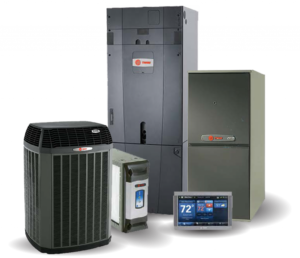
The heating and air conditioning industry can be complicated if you don’t know the language, so we want to help you make informed decisions by teaching you the most common terms you might come across when dealing with HVAC!
AHRI: the abbreviation for Air Conditioning, Heating, and Refrigeration Institute; the trade association that represents more than 350 manufacturers of HVAC equipment.
AFUE: the abbreviation for Annual Fuel Utilization Efficiency; it measures how efficiently a gas furnace can convert fuel to energy.
Air Conditioner: a system that controls the differing levels of temperature, humidity, and ventilation typically in an indoor setting to maintain comfortable temperatures.
Air Handler: often abbreviated AHU; regulates the circulating air in an indoor environment.
BTU: also known as a british thermal unit; measures the amount of heat that an air conditioning system can remove per hour.
Carbon Monoxide: a poisonous, odorless, tasteless, and colorless gas that is produced when fuels burn with insufficient air.
Capacity: the amount of heat an air conditioning system can remove.
Condenser: one of the main parts of an air conditioning system that cools down and condenses incoming refrigerant vapor into liquid.
Compressor: one of the main parts of an air conditioning system that raises the pressure of the refrigerant to move it through the unit.
Damper: a movable plate in the ductwork that regulates airflow and directs it to the areas that need it most.
Ductwork: the system or network of tubes used to transport air from a heating and air conditioning unit.
Energy Star: a United States Environmental Protection Agency program that certifies companies and individuals to save energy, save money, and protect the climate.
Evaporator Coil: the part of the air conditioning system that absorbs heat from the air.
EER: the abbreviation for energy efficiency ratio; the ratio of output cooling energy to input electrical energy.
EPA: the abbreviation for the United States Environmental Protection Agency.
Furnace: the part of a heating and air conditioning system that heats the air by burning fuel in a heat exchanger.
Heat Exchanger: moves heat from the hot parts of the system to the cooler part of the system.
Heat Pump: a compressor that moves heat to a colder place by cycling through the warm air.
Humidifier: a system that is designed to keep a space moist.
Humidistat: a device used to monitor and maintain the humidity of a space.
HVAC: the abbreviation for a heating and air conditioning system.
Indoor Coil: another name for the evaporator coil.
Load: the amount of heating or cooling a building requires.
NATE: the abbreviation for North American Technician Excellence; the United States’ largest non-profit organization that certifies installation technicians with a knowledge based test.
Outdoor Coil: another name for the condenser.
Package Unit: a heating and air conditioning system that comprises all of its parts in a single-boxed cabinet.
Refrigerant: a chemical used in an HVAC system as a heat carrier which changes from gas to liquid and then back to gas.
Refrigerant Lines: two lines made of copper material that are used to connect an outdoor air conditioner to the indoor evaporator coil.
R-22: commonly identified as the chemical Freon; a refrigerant that keeps the air cool and is used in most AC units older than 10 years of age.
R-410A: a chlorine-free refrigerant that was developed by the EPA as an alternative to R-22 (Freon) which is recommended with newer AC units.
SEER: the abbreviation for Seasonal Energy Efficiency Ratio; the ratio of cooling output during a season when the cooling setting is high to total electric energy input.
Single Speed: a type of HVAC system that is consistently on full-power until it reaches the desired temperature and then the system returns to the off position.
Split System: the combination of an outdoor and an indoor system.
Thermidistat: a device that monitors and maintains temperature and humidity in an indoor space.
Thermostat: a device used to monitor and regulate a heating and air conditioning system.
Upflow Furnace: a furnace that takes in air through the side or bottom and pushes it out through the top.
Ventilator: a device that replaces the stagnant indoor air with fresh outdoor air in a home or business.
Zoning system: a process that sections out different zones of a space to best accommodate the differing temperatures.
At Coastal Home Services, we want our clients to understand all that we offer and really see the value in our services. We would love to answer any further questions you may have concerning your heating and air conditioning system! Give our Trane® certified team a call or fill out our online contact form.


